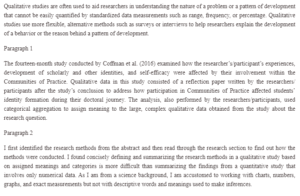Qualitative Studies
Hi Laura,
Great work with your post! I agree with you that qualitative studies are used to create an understanding of aspects that cannot be quantified. They are also ideal for uncovering concepts that researchers have not identified in the past. These aspects or concepts usually reside among respondents’ opinions, perceptions, beliefs, cultures, and practices. Researchers identify these concepts through observation, interviews, surveys, case studies, focus groups, or active participation and answer questions about how or why (Tenny, Brannan, & Brannan, 2021).
The study sought to establish the identity formation of doctoral students as they graduate to become scholars. As earlier suggested, qualitative studies penetrate the human mind to create an understanding of their experiences through interpretation. As highlighted in your post, reflection papers were used to gain insight into the respondents’ thoughts. The study used the detailed description as the main data collection procedure. The data analysis process involved coding common themes in the reflection papers. This method emphasizes the flexible nature of qualitative studies, which improves their ability to reveal intangible or immeasurable aspects that affect respondents’ behaviors and lifestyles (Coffman, Putman, & Adkisson, 2016).
I agree that qualitative research is different from quantitative. It may seem more difficult due to the shift for people accustomed to quantitative research. However, the flexibility and ability to descriptively highlight findings add an interesting twist to research. Unlike quantitative research, where numerals dictate the conclusion, qualitative research findings can vary from one group of respondents to another due to differences in perceptions, behaviors, experiences, or beliefs. This difference makes qualitative studies more interesting than quantitative studies. The difficulty you experience with qualitative studies can become motivation through exploration with an open mind.
References
Coffman, K., Putman, P., & Adkisson, A. (2016). Waiting for the Expert to Arrive: Using a Community of Practice to Develop the Scholarly Identity of Doctoral Students. International Journal of Teaching and Learning in Higher Education, 28(1), 30-37.
Tenny, S., Brannan, G. D., & Brannan, J. M. (2021). Qualitative Study.
ORDER A PLAGIARISM-FREE PAPER HERE
We’ll write everything from scratch
Question 
Qualitative studies are often used to aid researchers in understanding the nature of a problem or a pattern of development that cannot be easily quantified by standardized data measurements such as range, frequency, or percentage. Qualitative studies use more flexible, alternative methods such as surveys or interviews to help researchers explain the development of a behavior or the reason behind a pattern of development.

Qualitative Studies
Paragraph 1
The fourteen-month study conducted by Coffman et al. (2016) examined how the researcher’s/participant’s experiences, development of scholarly and other identities, and self-efficacy were affected by their involvement within the Communities of Practice. Qualitative data in this study consisted of a reflection paper written by the researchers/ participants after the study’s conclusion to address how participation in Communities of Practice affected students’ identity formation during their doctoral journey. The analysis, also performed by the researchers/participants, used categorical aggregation to assign meaning to the large, complex qualitative data obtained from the study about the research question.
Paragraph 2
I first identified the research methods from the abstract and then read through the research section to find out how the methods were conducted. I found concisely defining and summarizing the research methods in a qualitative study based on assigned meanings and categories is more difficult than summarizing the findings from a quantitative study that involves only numerical data. As I am from a science background, I am accustomed to working with charts, numbers, graphs, and exact measurements but not with descriptive words and meanings used to make inferences.
Laura
References
Coffman, K., Putman, P., Adkisson, A., Kriner, B., & Monaghan, C. (2016). Waiting for the expert to arrive: Using a community of practice to develop the scholarly identity of doctoral students. International Journal of Teaching and Learning in Higher Education, 28(1), 30-37. https://files.eric.ed.gov/fulltext/EJ1106332.pdf